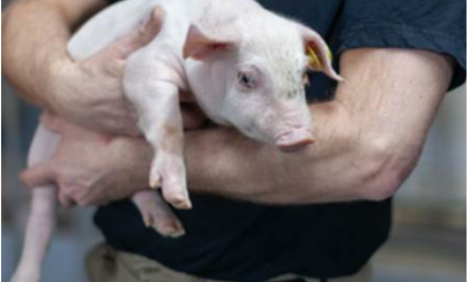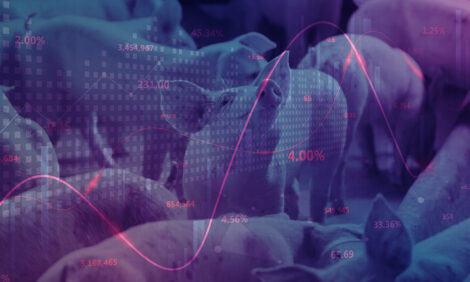



Is Reducing Soybean Meal Use a Wise Move?
By Duane Reese, Nebraska University Extension Swine Specialist and Al Prosch, NU Pork Central Coordinator - Rising soybean meal prices have prompted some pork producers to consider reducing the amount of soybean meal in grow-finish swine feeds in an attempt to reduce diet cost.
When soybean meal is removed from the diet, the amino acid content of the diet will decrease
unless crystalline forms of amino acids are added. Lower dietary amino acid levels may result in
reduced growth performance and carcass merit depending the level of amino acids being fed
currently. The issue for producers to address for their individual operation is does the saving in
diet cost resulting from reduced soybean meal usage more than offset the effects of reduced
performance that will likely occur?
To help producers address that issue, we provided data where the effect of increasing lysine:calorie ratio in 220 to 265 lb finishing barrows and gilts (PIC 337 X C22) grown in commercial facilities was examined (Tables 1 and 2).
The lysine:calorie ratios were altered by adjusting the ratio of corn to soybean meal in the diet. Dietary lysine density is also shown as percent of the diet. We calculated income over feed for pigs fed each diet assuming the value of corn and 46.5% soybean meal was $2.71/bu and $277/ton, respectively.
Income over feed increased as dietary lysine density increased to .74% in gilts (Table 1). As expected, income over feed was maximized at a lower level of lysine (.6%) in barrows (Table 2).
These lysine levels are similar to those reported in the Nebraska and South Dakota Swine Nutrition Guide for high lean gain pigs. Although the price of soybean has increased significantly, its value has not increased enough relative to corn to justify removing soybean meal from the finisher diet in an attempt to reduce diet costs.
The relationship between corn price and soybean meal would need to widen significantly before removing meal. It is a relationship to watch but for now, producers may want to consider keeping very current in their marketing and staying at the lower end of the their best weight range. This is an action directed at total pounds of pork marketed, which in 2004 could become burdensome.

Source: University of Nebraska's Pork Central - February 2004
To help producers address that issue, we provided data where the effect of increasing lysine:calorie ratio in 220 to 265 lb finishing barrows and gilts (PIC 337 X C22) grown in commercial facilities was examined (Tables 1 and 2).
The lysine:calorie ratios were altered by adjusting the ratio of corn to soybean meal in the diet. Dietary lysine density is also shown as percent of the diet. We calculated income over feed for pigs fed each diet assuming the value of corn and 46.5% soybean meal was $2.71/bu and $277/ton, respectively.
Income over feed increased as dietary lysine density increased to .74% in gilts (Table 1). As expected, income over feed was maximized at a lower level of lysine (.6%) in barrows (Table 2).
These lysine levels are similar to those reported in the Nebraska and South Dakota Swine Nutrition Guide for high lean gain pigs. Although the price of soybean has increased significantly, its value has not increased enough relative to corn to justify removing soybean meal from the finisher diet in an attempt to reduce diet costs.
The relationship between corn price and soybean meal would need to widen significantly before removing meal. It is a relationship to watch but for now, producers may want to consider keeping very current in their marketing and staying at the lower end of the their best weight range. This is an action directed at total pounds of pork marketed, which in 2004 could become burdensome.
Table 1. Effect of lysine:calorie ratio on 220 to 265 lb gilts fed a diet containing 6% added fata  aGrowth and carcass data from the 2002 Kansas State University Swine Report. A total of 1,021 gilts (PIC) housed at 21 to 25 pigs/pen for 25 days. bCalculated to correspond to a non-fat supplemented, corn-soybean meal. cLinear (P < .0001). dQuadratic (P < .04). eNational base price grid, March 2, 2004. fCorn = $2.71/bu and 46.5% CP soybean meal = $277/ton. |
Table 2. Effect of lysine:calorie ratio on 220 to 265 lb barrows fed a diet containing 6% added fata  aGrowth and carcass data from the 2002 Kansas State University Swine Report. A total of 968 barrows (PIC) housed at 22 to 24 pigs/pen for 21 days. bCalculated to correspond to a non-fat supplemented, corn-soybean meal. cLinear (P < .0001). dQuadratic (P < .0002). eNational base price grid, March 2, 2004. fCorn = $2.71/bu and 46.5% CP soybean meal = $277/ton. |

The market values were taken from the March 2, 2004 USDA National Base Price as reported.
Both gilts and barrows were assumed to have no other features that would prevent them from
being valued at or near the upper range of the grid based on back fat, loin depth and carcass
weight. The values used are estimates and do not reflect any individual buyers grid. Producers
should compare their own data and put values that match their buyers grid to determine exact
value on an individual buyer’s grid. As an example those buyers that favor heavier carcasses
with less discount for back fat would reward the heavier barrows more than shown in the table.
 |
 |
 |
 |
Source: University of Nebraska's Pork Central - February 2004








